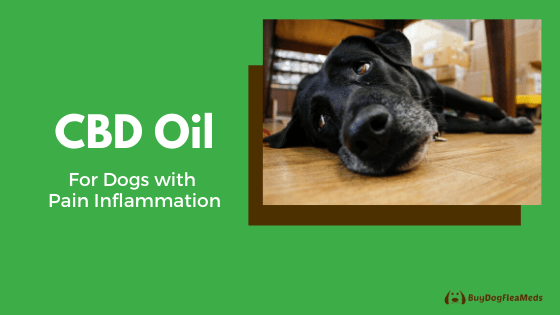Cbd Oil For Dogs With Pain Inflammation
Is your dog your best friend?
Of course they are!!
That’s why when you see them in great pain you want to help them get out of it- fast. Fortunately, there are many methods to treating your dogs pain such as pain meds, therapy, and other natural remedies such as CBD oil.
Let’s have a look at what pain is first to better understand what our pet is going through.
What Is Pain and Inflammation?
Pain and inflammation are actually 2 different ailments your pet can experience. However, since they are usually linked together we often mistaken it for just pain. Pain is an uncomfortable physical or emotional experience according to the International Association for the Study of Pain (IASP).
On the other hand, inflammation is the immunoligc response to injury of the tissue. You can tell there is an inflammation when you see accumulation of fluid and swelling within a certain region as the body mobilizes antibodies and white blood cells to that area for repair.
Pain and inflammation can be a serious condition for our fur babies to deal with. Like how it affects us humans, our pets can experience intermittent to constant pain which then restricts and limits their movement preventing them to perform even the simplest of functions.
You’ll notice your dog experiencing difficulties hopping up and going down the car, your cat won’t be as excited jumping to and from the countertop as it often does.
That’s because the slightest movement causes discomfort and pain.
It affects them significantly because movement plays an important role in the daily lives of our pets.
Here are a few reasons why your cat or your dog can be experiencing pain and inflammation and the various forms in which it could manifest.
Conditions Associated with Pain and Inflammation
Hip Dysplasia:
This condition is commonly observed in dogs and is caused by an irregular formation of the canine’s hip socket. In worse conditions, hip dysplasia can cause arthritis in the dog’s joint and can even cripple your pet. Hip dysplasia can be observed in larger dog breeds most possibly because of the ratio of the dog breed’s weight and the integrity of the bones in its pelvic area.
Joint Infection:
Joint infection happens when your pet encounters an injury that caused a penetrating wound damaging the joint. In these cases, infection can develop around the affected joint area.
Joint and Ligament Injury:
Overworking the joints, a bad bump, and twisting your pet’s paws (ankles) can cause pain and inflammation. Simple sprains and strains in cats and dogs suffered from bad falls can even lead to joint instability. Overworking the joints and the ligaments can cause excessive wear on the ligaments and on the joint area.
Arthritis:
While joint pain and inflammation can happen for several reasons, one of the most common cause of this condition in both cats and dogs is arthritis. Arthritis can come from many causes like age, obesity, and injury.
Inflammatory Bowel Disease:
Inflammatory Bowel Disease or IBD is a condition that involves the inflammation of your pet’s gastrointestinal walls. It induces indigestion which results to frequent vomiting and defecation. You’ll notice that your dog or your cat might start to lose weight and become frail. This is due to the decreased intake of both food and water because of lack of appetite.
Dermatitis:
Inflammation of the skin from excessive licking or biting. If left untreated, this can cause infection.
What are the Symptoms of Pain and Inflammation?
The symptoms of pain inflammation on cats and dogs vary. You’ll notice subtle symptoms from whines and whimpers at irregular intervals to constant irritability. Then there are the more obvious and alarming ones like soreness and hunches on your pet’s joints.
Here are some of the most common symptoms relating to pain and inflammation amongst pets.
Limping:
Dogs and cats may show difficulty in walking and may limp around raising the leg with the affected joint. They will often prefer to raise the affected leg finding it too painful to walk with it.
Indifference:
Cats and dogs will find daily activities less interesting. Walks become shorter and you may even find a hard time getting your dog out for a walk. Cats will be more reluctant to play around and will spend more time hiding. They’re just less concerned about “play time” finding it difficult to move.
Licking or Biting:
Cats and dogs experiencing pain and inflammation may lick and bite affected areas. Excessive licking and biting may even lead skin inflammation and hair loss.
Changes in Sleep and Eating Patterns:
A cat or a dog suffering from pain and inflammation may change its sleeping and eating patterns. Instead of adhering to habit, pets affected with inflammation and pain will often eat and sleep whenever convenient.
For your dog, finding a comfortable sleeping position won’t be as easy as before. Climbing up their favorite perch would seem more of a daunting task for your cat and sleeping somewhere else may take a little getting used to.
Dogs and cats with sore and swollen necks may find it difficult to even eat or drink.
How to Prevent Pet Pain Inflammation
If you don’t want your dog or your cat to suffer from pain inflammation, here are a few things you should keep in mind.
Keep Them Active:
An active pet is a healthy pet.
Give your dog enough play time, walking and running helps your dog burn fat and direct pent-up energy to a beneficial activity. Give your cat enough room to play around, dedicate a time of day where you can play with your cat. This will help keep them busy and appeases their curiosity.
Remember that obesity is one of the main causes of health issues in both humans and pets. Keeping them active keeps them happy and healthy.
Watch What They Eat:
There’s more to just feeding your pet. Avoid giving them too much food as this can make them fat. It also pays to read the label on dog and cat food as well as on pet treats before buying one.
Find a Safe Space for Your Pets:
Before you let the dogs out, check the play area or your backyard for potholes as these can cause strains and sprains that may lead to joint injury and inflammation. Check for sharp objects that may wound your dog and even cause infection.
How to Treat Pain and Inflammation Naturally in Your Pet
Treatment and management of pain, inflammation, and arthritis amongst pets involve a wide array of NSAIDs (Non-Steroidal Anti-Inflammatory Drugs) and other natural methods like home remedies and CBD-infused medication.
Deciding on which avenue to take in helping your pets deal with pain and inflammation must always be with the guidance of a veterinarian. In fact, when used without proper caution NSAIDs and other chemical-based medication can harm your pets in the long run. Some of the known side effects of NSAIDs are vomiting, loss of appetite, reduced activity amongst pets from active breeds, and in some cases, diarrhea.
In worse cases, NSAIDs can cause damage in your pets’ liver, kidneys, and in their digestive tract.
This is why many pet owners look to natural home remedies for a safer means of remediating inflammation and reducing pain. These natural remedies offer a less-synthetic means of dealing with pet inflammation.
Here are a few.
Tea:
Pet tea can be made from a slew of ingredients available within reach. Some of these include turmeric and ginger.
Salves and Dermal Treatment:
Some plants can be made into paste and used as salves on skin inflammation like turmeric. Arnica can be used to treat inflammation and pain externally.
CBD:
CBD-infused medicines or CBD oils are products that contain CBD. CBD is a compound found in hemp and in cannabis. CBD oils with no THC is great for pets both reducing inflammation and tension.
CBD products will help you and your pet manage pain and inflammation without any negative side effects.
How Much CBD Should I Give My Dog or Cat with Pain Inflammation?
When dosing CBD for dogs and cats, it’s best to ask your veterinarian for help. CBD products for pets will also have some form of reference in dosing. Nevertheless, if you’re looking for the right dosage for your furry friend the basic rule is to give only 1 – 5 mg of CBD for every 10 pounds of body mass administered once or twice every day.
References:
https://www.petmd.com/dog/slideshows/care/7-signs-of-arthritis-in-dogs-cats
https://www.fda.gov/animal-veterinary/animal-health-literacy/get-facts-about-pain-relievers-pets
https://sitstay.com/blogs/good-dog-blog/natural-anti-inflammatories-for-dogs
https://www.allthebestpetcare.com/pet-nutrition/cbd-dose-dog-cat/
https://www.iasp-pain.org/Education/Content.aspx?ItemNumber=1217

